| Weight | 1 lbs |
|---|---|
| Dimensions | 9 × 5 × 2 in |
| host | mouse |
| isotype | IgG1 |
| clonality | monoclonal |
| concentration | concentrate, predilute |
| applications | IHC |
| reactivity | human |
| available size | 0.1 mL, 0.5 mL, 1 mL concentrated, 7 mL prediluted |
mouse anti-CD22 monoclonal antibody (ZM183) 6077
Price range: $160.00 through $528.00
Antibody summary
- Mouse monoclonal to CD22
- Suitable for: Immunohistochemistry (formalin-fixed, paraffin-embedded tissues)
- Reacts with: Human
- Isotype:IgG1
- Control: Lymph node
- Visualization: Cytoplasmic
- 0.1, 0.5, 1.0 mL concentrated, 7 mL prediluted
mouse anti-CD22 monoclonal antibody ZM183 6077
| target relevance |
|---|
| Protein names B-cell receptor CD22 (B-lymphocyte cell adhesion molecule) (BL-CAM) (Sialic acid-binding Ig-like lectin 2) (Siglec-2) (T-cell surface antigen Leu-14) (CD antigen CD22) |
| Gene names CD22,CD22 SIGLEC2 |
| Protein family Immunoglobulin superfamily, SIGLEC (sialic acid binding Ig-like lectin) family |
| Mass 95348Da |
| Function FUNCTION: Most highly expressed siglec (sialic acid-binding immunoglobulin-like lectin) on B-cells that plays a role in various aspects of B-cell biology including differentiation, antigen presentation, and trafficking to bone marrow (PubMed:34330755, PubMed:8627166). Binds to alpha 2,6-linked sialic acid residues of surface molecules such as CD22 itself, CD45 and IgM in a cis configuration. Can also bind to ligands on other cells as an adhesion molecule in a trans configuration (PubMed:20172905). Acts as an inhibitory coreceptor on the surface of B-cells and inhibits B-cell receptor induced signaling, characterized by inhibition of the calcium mobilization and cellular activation. Mechanistically, the immunoreceptor tyrosine-based inhibitory motif domain is phosphorylated by the Src kinase LYN, which in turn leads to the recruitment of the protein tyrosine phosphatase 1/PTPN6, leading to the negative regulation of BCR signaling (PubMed:8627166). If this negative signaling from is of sufficient strength, apoptosis of the B-cell can be induced (PubMed:20516366). {ECO:0000269|PubMed:20172905, ECO:0000269|PubMed:20516366, ECO:0000269|PubMed:34330755, ECO:0000269|PubMed:8627166}. |
| Subellular location SUBCELLULAR LOCATION: Cell membrane {ECO:0000269|PubMed:20172905}; Single-pass type I membrane protein. |
| Tissues TISSUE SPECIFICITY: B-lymphocytes. |
| Structure SUBUNIT: Predominantly monomer of isoform CD22-beta. Also found as heterodimer of isoform CD22-beta and a shorter isoform. Interacts with PTPN6/SHP-1, LYN, SYK, PIK3R1/PIK3R2 and PLCG1 upon phosphorylation. Interacts with GRB2, INPP5D and SHC1 upon phosphorylation (By similarity). May form a complex with INPP5D/SHIP, GRB2 and SHC1. {ECO:0000250|UniProtKB:P35329, ECO:0000269|PubMed:7618087, ECO:0000269|PubMed:8627166, ECO:0000269|PubMed:8647200}. |
| Post-translational modification PTM: Phosphorylation of Tyr-762, Tyr-807 and Tyr-822 are involved in binding to SYK, GRB2 and SYK, respectively. Phosphorylation of Tyr-842 is involved in binding to SYK, PLCG2 and PIK3R1/PIK3R2. {ECO:0000250|UniProtKB:P35329}.; PTM: Phosphorylated on tyrosine residues by LYN. {ECO:0000250|UniProtKB:P35329}. |
| Domain DOMAIN: Contains 4 copies of a cytoplasmic motif that is referred to as the immunoreceptor tyrosine-based inhibitor motif (ITIM). This motif is involved in modulation of cellular responses. The phosphorylated ITIM motif can bind the SH2 domain of several SH2-containing phosphatases. |
| Target Relevance information above includes information from UniProt accession: P20273 |
| The UniProt Consortium |
Data
 |
| Human spleen stained with anti-CD22 antibody using peroxidase-conjugate and DAB chromogen. Note cytoplasmic staining of B-lymphocytes. |
Publications
| pmid | title | authors | citation |
|---|---|---|---|
| We haven't added any publications to our database yet. | |||
Protocols
| relevant to this product |
|---|
| IHC |
Documents
| # | SDS | Certificate | |
|---|---|---|---|
| Please enter your product and batch number here to retrieve product datasheet, SDS, and QC information. | |||
Only logged in customers who have purchased this product may leave a review.
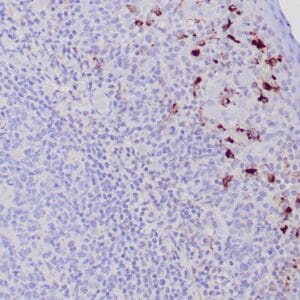

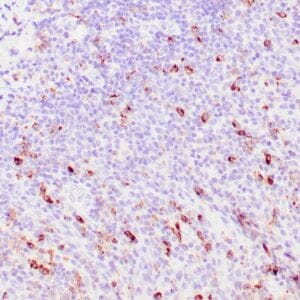

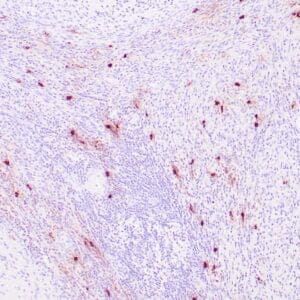

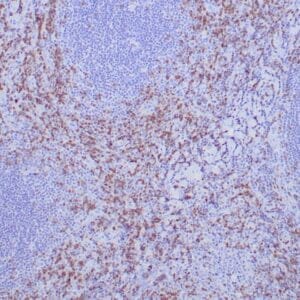

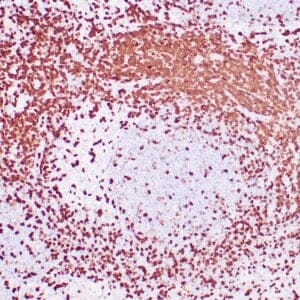
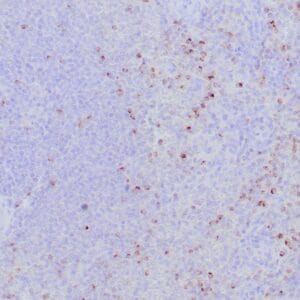
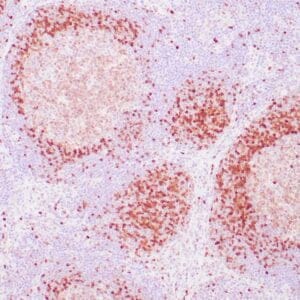
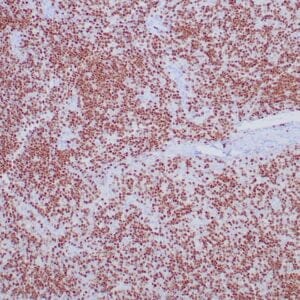
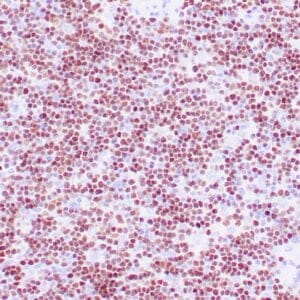
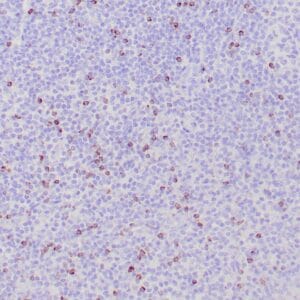
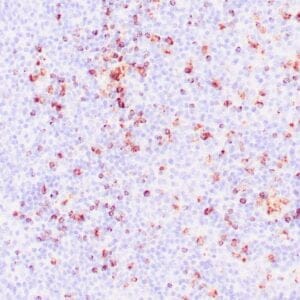
Reviews
There are no reviews yet.